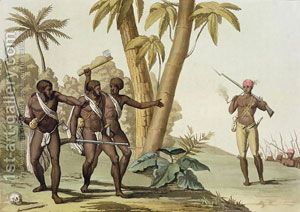THIS month of August, 2013 marks the 179th anniversary of Emancipation. It was on August 1, 1834, that the despicable system of slavery was abolished in all British colonies, including Guyana, the former British Guiana.
 Such a development emerged as a consequence of intense and persistent struggle, sacrifice and resistance by the victims themselves along with the valiant efforts of energetic supporters such as religious leaders, humanitarians, politicians and enlightened individuals of the day.
Such a development emerged as a consequence of intense and persistent struggle, sacrifice and resistance by the victims themselves along with the valiant efforts of energetic supporters such as religious leaders, humanitarians, politicians and enlightened individuals of the day.
Our history tells us that our Afro-Guyanese forefathers were first brought here to provide enslaved labour during the early decades of the 17th Century by the Dutch in their quest for settlement and colonization. This was part of a wider and forced movement of people from the continent of Africa to the West Indian islands and the Americas which started more than a century earlier.
Economic necessity
Slavery in the New World was institutionalized by the Europeans, on the grounds of economic necessity, through the Trans-Atlantic slave trade. The end-result was that millions of Africans were uprooted from their homeland through trickery, kidnapping, raids, bribery and other forms of deception and taken against their will to these parts, where they found themselves in the monstrous system of plantation slavery.
In order to justify their actions, Europeans quite arrogantly argued that slavery was in existence in Africa even before they made contact with that continent. But, let me hasten to say that the slavery which existed in Africa before the advent of New World slavery was a completely different system. It was more or less a social institution. Africans saw it as an honour and obligation to give service to their rulers in the army, in agriculture, in construction works and other areas of development. It was a relatively humane system which permitted upward social mobility and enhanced dignity and pride.
On the contrary, the slavery that emerged in the West Indies and the Americas, due to European imposition, was characterized by greed, injustice, cruelty and gross exploitation. There was nothing humane about the system, and the victims were reduced to the status of ‘properties or things’ of their masters. It is little wonder that prominent African scholar, Dr. Ajayi, aptly states that it is absurd to use the same word “slavery” to describe the two systems, the humane social institution in existence in Africa as against the very oppressive economic institution which unfolded in the New World as a consequence of European imposition.
Resistance
The Trans-Atlantic slave trade and plantation slavery were degrading, demoralizing and dehumanizing to the victims in every sense of the word. From the very outset, it required supreme sacrifice and valiant struggle to survive this obviously harsh and oppressive system.
It was not surprising , therefore, that resistance quickly became an integral part of the system. Our foreparents resisted capture on the African continent itself; they adopted innovative methods of resistance on board the overcrowded slave ships while crossing the Middle or Atlantic Passage; and on the plantations, they justifiably intensified their resistance to the system of enslaved labour.
Those varied forms of passive and active resistance clearly demonstrated their determination as a people, and their non-compliance with the evils of bondage and oppression. Malingering, feigning illness or ignorance, hunger strike, deliberately doing poor work, self-inflicted actions, damage to master’s property, maroonage, and slave rebellions were all part of the strategy to undermine the economic, social, political and cultural dominance the master class enjoyed at the expense of the victims.
The 1763 Berbice Revolt and the heroic efforts of Cuffy, Atta, Accabre and others must certainly have been an inspiration to many in the cause of Emancipation. The same could be said of other slave rebellions, including the 1823 East Coast Insurrection which vividly illustrated the slaves’ desire for freedom.
These very actions of the enslaved Africans undoubtedly instilled fear and uncertainty in the minds of the plantocracy. Above all, they contributed significantly to complementing the efforts of those within the Anti-Slavery Movement to sensitize and mould public opinion in the furtherance of Emancipation.
In the final analysis, the ongoing struggle, sacrifice and resistance bore fruit, as the British Emancipation Act was passed in 1833 and came into force on August 1, 1834, bringing to an end the atrocious system of slavery, which, for centuries, had brought so much pain, suffering and bitterness.
Transition period
As a matter of fact, at midnight of July 31, 1834, an estimated ¾ of a million men, women and children ceased to be slaves. In the case of Guyana, it meant that approximately 85,000 enslaved Africans became ‘partially freed’ in 1834. It was considered ‘partially freed’, because, in reality, it was not ‘full freedom’ in the initial stage. The Emancipation Act catered for a period of transition, called the apprenticeship system, under which the ex-slaves were apprenticed to their former masters. This apprenticeship system lasted for four years, 1834-1838, before ‘full freedom’ was achieved.
During this period, the apprentices had to provide compulsory unpaid labour, to the extent of three-quarters the working week for their former masters, while the remaining quarter working week they were expected to earn wages.
By opting for the apprenticeship period, the British Government intended to have a smooth transition from slavery to full freedom. It also wanted to ensure a continuous labour supply to plantation owners thereby ensuring the survival of the dominant sugar industry.
Indeed, the piece of legislation which ended slavery hinted at momentous, far-reaching changes in the society; it transformed the legal status of more than 80 per cent of the population by abolishing the legal oddity of property in person, and by substituting equality for all before the law.
It altered the labour base of the society by substituting a wage labour system for unpaid slave labour. It outlined the basis for the existence of a greatly enlarged body of free persons by removing the legal authority which had, over the years, enabled a small elite group (the planters) to exercise unlimited arbitrary power over the activities and lives of the overwhelming majority (enslaved Africans).
In reality, Emancipation and Apprenticeship created problems. The ex-slaves, quite rightly, could not understand why they had to be apprenticed to their former masters, and at the same time being told that they were free. Planters made life more difficult for them by adopting an increasingly hostile attitude. They wanted to extract as much labour out of the apprentices before the period was over. They arbitrarily deducted wage rates, and even withdrew basic supplies. They indulged in unjust provocation, and apprentices had to fend for themselves. They brazenly practised many features of slavery.
This state of affairs led to the heroic passive resistance by Damon and his followers on the Essequibo Coast in 1834, and by labourers elsewhere. It was not surprising, therefore, that the system of Apprenticeship came to a premature end in 1838, and full freedom was eventually achieved.
Fresh start
Undoubtedly, the ex-slaves had high hopes, aspirations and expectations with the coming of Emancipation. Their mass exodus from the plantations during the critical period of “crisis, experimentation and change” is testimony to this.
Several decades of cruelty and injustice under the slavery system had resulted in the plantation being seen as the symbol of dehumanization, degradation and demoralization as far as the victims were concerned.
They quite naturally wanted to rid themselves of planter-class social, cultural and political domination, and at the same time they were very keen to assert their economic independence, largely through agricultural activities. They wanted to start life afresh and with dignity and pride.
In spite of the tremendous difficulties these freed men faced, it was with great determination and enthusiasm that they embarked on the village movement commencing with the admirable communal purchase of Northbrook (now Victoria) and other abandoned estates countrywide. Through their laudable efforts many communal and even proprietary villages emerged. Within a few years after emancipation the African village population had by far outnumbered that of the estates. Associated with this was their cash crop cultivation which resulted in a vibrant and rapidly expansive peasantry.
In the face of planter class antagonism, inadequate finance for capital investment and infrastructural development, periodic flooding and destruction of crops, exorbitant land prices and high rentals, virtually non-existent transportation and marketing facilities, restrictive ordinances and some unsympathetic administrators, the ex-slaves and their descendants persisted in the 19th Century.
It was the free village life which initiated development in many rural communities such as the establishment of churches, schools, roads, bridges, sea defence structures, drainage and irrigation canals and of added significance, village management. The latter was local democracy in its infancy stage.
Emancipation Month is certainly an occasion for rejoicing and at the same time one for sober reflection. Our Afro-Guyanese fore-fathers who endured slavery with all its viciousness have paid the supreme sacrifice through their toils, perils and lives to help lay the foundation for our country’s development.
Their descendants have over the years given, and continue to give, invaluable contribution to every sphere of activity including the social, economic, cultural and political fields. Some of our very prominent politicians, religious leaders, trade unionists, professionals, agriculturalists, miners, sports personalities, businessmen, artistes, industrialists and the like, are descendants of those Africans who dedicated their lives for betterment.
This is clearly a time for us to take inspiration as we strenuously strive for full national unity so necessary for our country’s continued progress and the well-being of all Guyanese.
I salute our African brothers and sisters and indeed all Guyanese on the occasion of our 179th Anniversary of Emancipation. Of added significance, this year marks the 250th Anniversary of the Berbice Slave Revolt and the 190th Anniversary of the East Coast Demerara Insurrection, two very related historic milestones. HAPPY EMANCIPATION MONTH TO ONE AND ALL! (Tota C. Mangar is Senior Lecturer and former Deputy Vice-Chancellor, UG)




.png)









